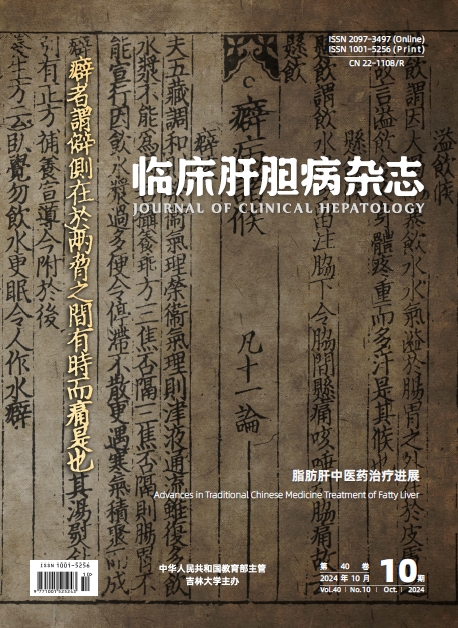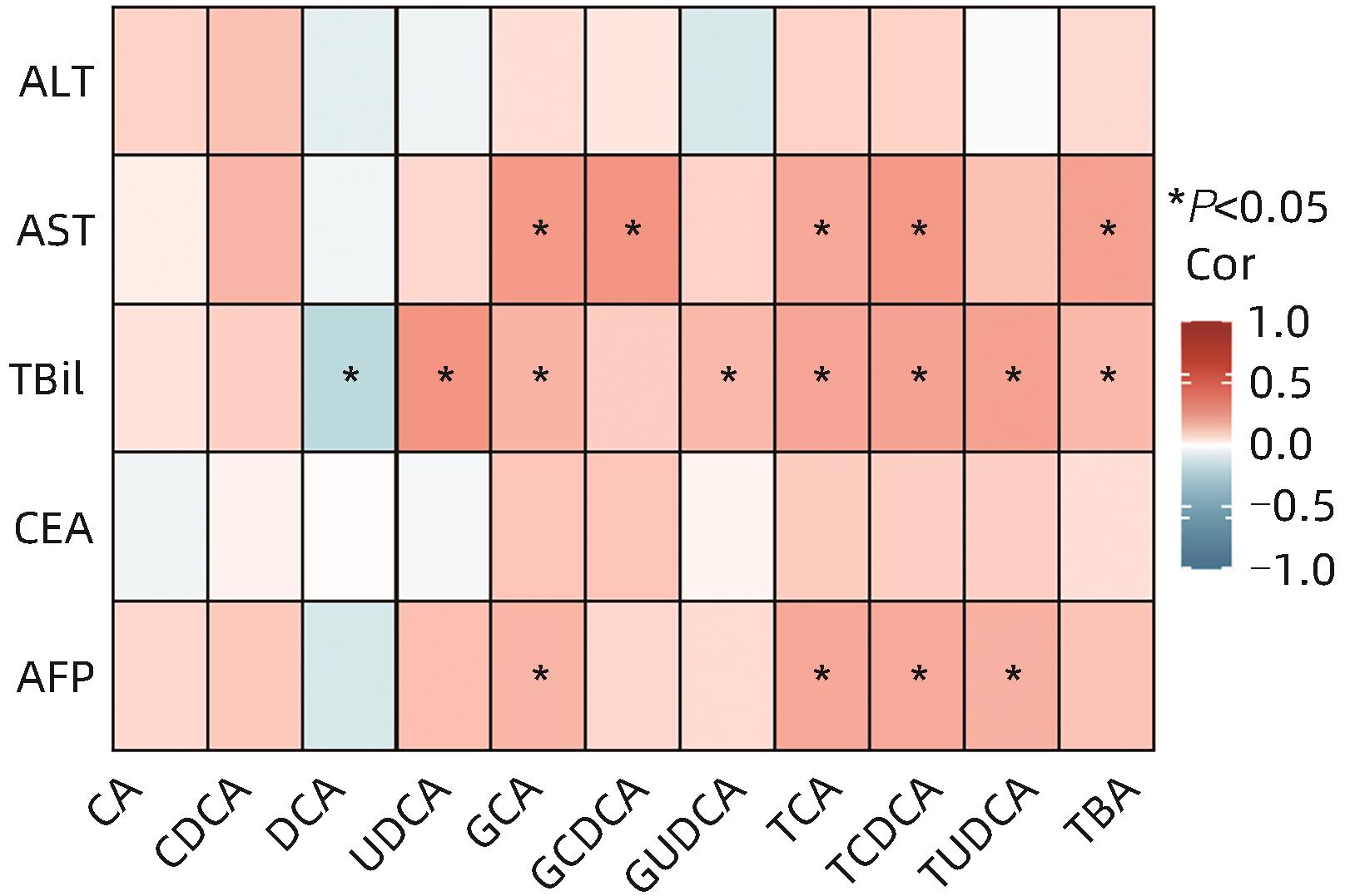| [1] |
JIA W, XIE GX, JIA WP. Bile acid-microbiota crosstalk in gastrointestinal inflammation and carcinogenesis[J]. Nat Rev Gastroenterol Hepatol, 2018, 15( 2): 111- 128. DOI: 10.1038/nrgastro.2017.119. |
| [2] |
CHÁVEZ-TALAVERA O, TAILLEUX A, LEFEBVRE P, et al. Bile acid control of metabolism and inflammation in obesity, type 2 diabetes, dyslipidemia, and nonalcoholic fatty liver disease[J]. Gastroenterology, 2017, 152( 7): 1679- 1694.e3. DOI: 10.1053/j.gastro.2017.01.055. |
| [3] |
SMIRNOVA E, MUTHIAH MD, NARAYAN N, et al. Metabolic reprogramming of the intestinal microbiome with functional bile acid changes underlie the development of NAFLD[J]. Hepatology, 2022, 76( 6): 1811- 1824. DOI: 10.1002/hep.32568. |
| [4] |
CHEN T, WANG L, XIE G, et al. Serum bile acids improve prediction of Alzheimer's progression in a sex-dependent manner[J]. Adv Sci(Weinh), 2024, 11( 9): e2306576. DOI: 10.1002/advs.202306576. |
| [5] |
SONG WS, PARK HM, HA JM, et al. Discovery of glycocholic acid and taurochenodeoxycholic acid as phenotypic biomarkers in cholangiocarcinoma[J]. Sci Rep, 2018, 8( 1): 11088. DOI: 10.1038/s41598-018-29445-z. |
| [6] |
JI SY, LIU QX, ZHANG SH, et al. FGF15 activates hippo signaling to suppress bile acid metabolism and liver tumorigenesis[J]. Dev Cell, 2019, 48( 4): 460- 474. e 9. DOI: 10.1016/j.devcel.2018.12.021. |
| [7] |
SUN RQ, ZHANG ZY, BAO RX, et al. Loss of SIRT5 promotes bile acid-induced immunosuppressive microenvironment and hepatocarcinogenesis[J]. J Hepatol, 2022, 77( 2): 453- 466. DOI: 10.1016/j.jhep.2022.02.030. |
| [8] |
LIU ZR, JIA XD, LU YY. Research advances in hepatocellular carcinoma-related imbalance of bile acid metabolism and related regulatory mechanism[J]. J Clin Hepatol, 2021, 37( 3): 690- 694. DOI: 10.3969/j.issn.1001-5256.2021.03.038. |
| [9] |
SYDOR S, BEST J, MESSERSCHMIDT I, et al. Altered microbiota diversity and bile acid signaling in cirrhotic and noncirrhotic NASH-HCC[J]. Clin Transl Gastroenterol, 2020, 11( 3): e00131. DOI: 10.14309/ctg.0000000000000131. |
| [10] |
PETRICK JL, FLORIO AA, KOSHIOL J, et al. Prediagnostic concentrations of circulating bile acids and hepatocellular carcinoma risk: REVEAL-HBV and HCV studies[J]. Int J Cancer, 2020, 147( 10): 2743- 2753. DOI: 10.1002/ijc.33051. |
| [11] |
LI YY, LI JJ, SHI HF, et al. Advances in imaging research on source identification of primary liver metastases[J]. J Clin Radiol, 2023, 42( 5): 878- 881. DOI: 10.13437/j.cnki.jcr.2023.05.007. |
| [12] |
JIA W, WEI ML, RAJANI C, et al. Targeting the alternative bile acid synthetic pathway for metabolic diseases[J]. Protein Cell, 2021, 12( 5): 411- 425. DOI: 10.1007/s13238-020-00804-9. |
| [13] |
LI TG, CHIANG JYL. Bile acid signaling in metabolic disease and drug therapy[J]. Pharmacol Rev, 2014, 66( 4): 948- 983. DOI: 10.1124/pr.113.008201. |
| [14] |
WANG CZ, YANG MY, ZHAO JF, et al. Bile salt(glycochenodeoxycholate acid) induces cell survival and chemoresistance in hepatocellular carcinoma[J]. J Cell Physiol, 2019, 234( 7): 10899- 10906. DOI: 10.1002/jcp.27905. |
| [15] |
MA C, HAN MJ, HEINRICH B, et al. Gut microbiome-mediated bile acid metabolism regulates liver cancer via NKT cells[J]. Science, 2018, 360( 6391): eaan5931. DOI: 10.1126/science.aan5931. |
| [16] |
SARKAR J, AOKI H, WU RR, et al. Conjugated bile acids accelerate progression of pancreatic cancer metastasis via S1PR2 signaling in cholestasis[J]. Ann Surg Oncol, 2023, 30( 3): 1630- 1641. DOI: 10.1245/s10434-022-12806-4. |
| [17] |
CHENG P, WU JW, ZONG GF, et al. Capsaicin shapes gut microbiota and pre-metastatic niche to facilitate cancer metastasis to liver[J]. Pharmacol Res, 2023, 188: 106643. DOI: 10.1016/j.phrs.2022.106643. |
| [18] |
HAN J, QIN WX, LI ZL, et al. Tissue and serum metabolite profiling reveals potential biomarkers of human hepatocellular carcinoma[J]. Clin Chim Acta, 2019, 488: 68- 75. DOI: 10.1016/j.cca.2018.10.039. |
| [19] |
LUO P, YIN PY, HUA R, et al. A Large-scale, multicenter serum metabolite biomarker identification study for the early detection of hepatocellular carcinoma[J]. Hepatology, 2018, 67( 2): 662- 675. DOI: 10.1002/hep.29561. |
| [20] |
XIAN LF, FANG LT, LIU WB, et al. Epidemiological status, main pathogenesis and prevention and control strategies of primary liver cancer[J]. Chin J Oncol Prev Treat, 2022, 14( 3): 320- 328. DOI: 10.3969/j.issn.1674-5671.2022.03.13. |
| [21] |
The Society of Liver Cancer, China Anti-Cancer Association. CACA guidelines for holistic integrative management of cancer-liver cancerpart[J/CD]. J Multidiscip Cancer Manag Electron Version, 2022, 8( 3): 31- 63. DOI: 10.12151/JMCM.2022.03-06. |
| [22] |
TIAN CX, ZHAO L. Epidemiological characteristics of colorectal cancer and colorectal liver metastasis[J]. Chin J Cancer Prev Treat, 2021, 28( 13): 1033- 1038. DOI: 10.16073/j.cnki.cjcpt.2021.13.12. |
| [23] |
WANG ZJ, KIM SY, TU W, et al. Extracellular vesicles in fatty liver promote a metastatic tumor microenvironment[J]. Cell Metab, 2023, 35( 7): 1209- 1226. e 13. DOI: 10.1016/j.cmet.2023.04.013. |
| [24] |
XIAO JF, VARGHESE RS, ZHOU B, et al. LC-MS based serum metabolomics for identification of hepatocellular carcinoma biomarkers in Egyptian cohort[J]. J Proteome Res, 2012, 11( 12): 5914- 5923. DOI: 10.1021/pr300673x. |
| [25] |
ZENG HW, UMAR S, RUST B, et al. Secondary bile acids and short chain fatty acids in the colon: A focus on colonic microbiome, cell proliferation, inflammation, and cancer[J]. Int J Mol Sci, 2019, 20( 5): 1214. DOI: 10.3390/ijms20051214. |
| [26] |
LI JY, GILLILLAND M 3rd, LEE AA, et al. Secondary bile acids mediate high-fat diet-induced upregulation of R-spondin 3 and intestinal epithelial proliferation[J]. JCI Insight, 2022, 7( 19): e148309. DOI: 10.1172/jci.insight.148309. |
| [27] |
CHEN TL, XIE GX, WANG XY, et al. Serum and urine metabolite profiling reveals potential biomarkers of human hepatocellular carcinoma[J]. Mol Cell Proteomics, 2011, 10( 7): M110.004945. DOI: 10.1074/mcp.M110.004945. |
| [28] |
COLLINS SL, STINE JG, BISANZ JE, et al. Bile acids and the gut microbiota: Metabolic interactions and impacts on disease[J]. Nat Rev Microbiol, 2023, 21( 4): 236- 247. DOI: 10.1038/s41579-022-00805-x. |
| [29] |
ZHANG YF, LI MC. Application value of chitosanase 3-like protein 1, alpha-fetoprotein, glycoactrin 19-9, glutamyltranspeptidase in the early diagnosis of primary liver cancer[J]. Chin J Health Lab Technol, 2023, 33( 4): 467- 470.
张艳芬, 李明才. 血清壳多糖酶3样蛋白1、甲胎蛋白、糖类抗原19-9及谷氨酰转肽酶在原发性肝癌早期诊断中的应用价值[J]. 中国卫生检验杂志, 2023, 33( 4): 467- 470.
|
| [30] |
YANG YP, XU EJ, WANG XX, et al. The value of GNB4 and Riplet gene methylation detection in the diagnosis of primary liver cancer[J]. Acta Univ Med Anhui, 2024, 59( 2): 357- 362. DOI: 10.19405/j.cnki.issn1000-1492.2024.02.028. |
| [31] |
ZHANG JL, SHEN Q, WANG N, et al. Values of serum 7 microRNAs alone or in combination with α-fetoprotein in diagnosing hepatocellular carcinoma[J]. Acad J Nav Med Univ, 2023, 44( 5): 636- 639. DOI: 10.16781/j.cn31-2187/r.20220648. |















 DownLoad:
DownLoad:

